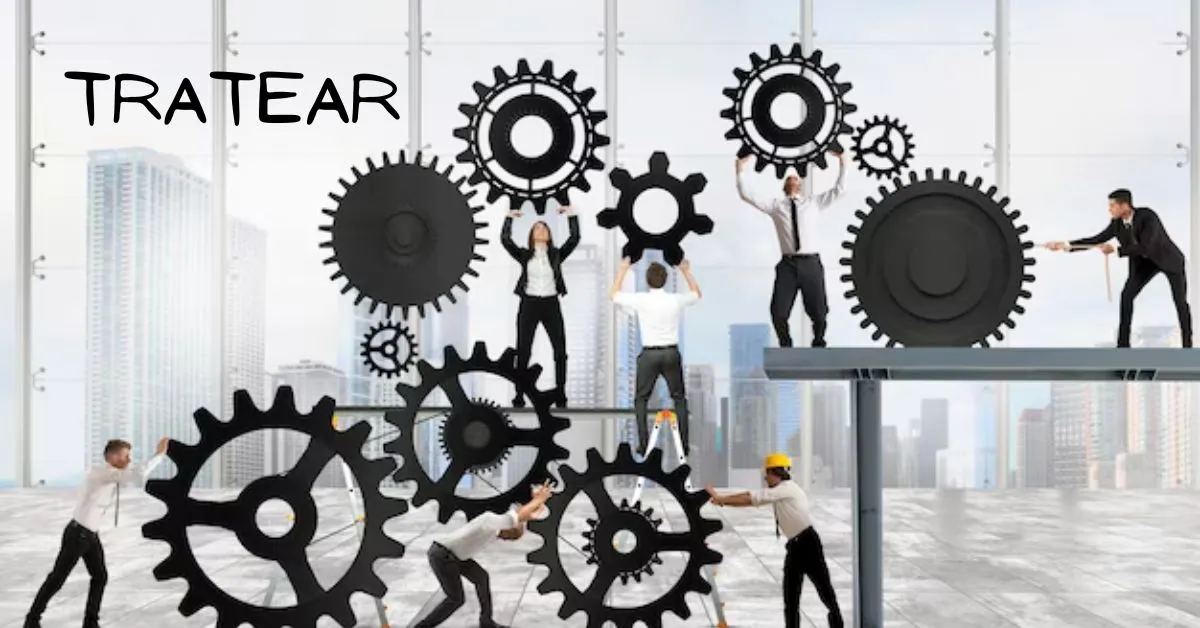Technology
Tratear: Revolutionizing Tech for Efficiency and Sustainability

Technology
The Ultimate Guide to Understanding and Using Tip Screens

Tip screens are digital or physical interfaces that allow customers to leave tips for service providers. These screens have become increasingly popular in various industries, from restaurants to ride-sharing services, offering a modern twist on the traditional tipping method.
Importance of Understanding Tip Screens
In today’s fast-paced, tech-savvy world, understanding how tip screens work and their benefits is crucial for both businesses and customers. This knowledge can enhance customer experience, streamline payment processes, and even increase overall tips for employees.
The Evolution of Tip Screens
Historical Background
The concept of tipping has been around for centuries, but the introduction of tip screens is a relatively recent development. Initially, tipping was a straightforward cash transaction, but as digital payments grew, the need for a more sophisticated tipping method emerged.
Tip Screens in the Digital Age
With the rise of digital payments, tip screens have evolved from simple cash registers to advanced digital interfaces integrated into POS systems, mobile apps, and even wearable technology. This evolution reflects the broader trend towards a cashless society.
Types of Tip Screens
Traditional Tip Screens
These are the basic interfaces often found in restaurants and cafes, typically part of the POS system where customers can select a tip percentage or enter a custom amount.
Digital Tip Screens
More advanced than their traditional counterparts, digital tip screens offer features like personalized tipping suggestions, loyalty program integration, and even customer feedback options.
Mobile Tip Screens
Used in services like ride-sharing and food delivery, mobile tip screens are integrated into apps, allowing customers to tip directly from their smartphones.
How Tip Screens Work
Basic Mechanism
Tip screens work by providing customers with an interface to select a tip amount after a service is rendered. This can be a physical screen attached to a POS system or a digital interface within a mobile app.
Advanced Features in Digital Tip Screens
Modern tip screens come with various advanced features such as dynamic tip suggestions based on service quality, integration with customer loyalty programs, and real-time feedback collection.
Benefits of Using Tip Screens
For Businesses
Tip screens can streamline the payment process, reduce the need for cash handling, and potentially increase overall tips by making the tipping process more convenient for customers.
For Customers
Customers benefit from the convenience and security of digital tipping. They can easily add a tip using their preferred payment method, without needing to carry cash.
For Employees
Employees often see an increase in tips when tip screens are used, as the digital prompts can encourage higher tipping amounts compared to traditional methods.
Challenges and Drawbacks
Technical Issues
Like any digital system, tip screens can encounter technical problems, from software glitches to hardware malfunctions, which can disrupt the tipping process.
Customer Reluctance
Some customers may be hesitant to use tip screens due to privacy concerns or unfamiliarity with the technology.
Security Concerns
Ensuring the security of digital payments and protecting customer data are paramount. Businesses must implement robust security measures to prevent breaches.
Implementing Tip Screens in Your Business
Choosing the Right Type
Consider the nature of your business and your customers when selecting a tip screen. For instance, a high-end restaurant might benefit from a sophisticated digital system, while a small café might opt for a simpler setup.
Installation Process
Proper installation is crucial for the seamless operation of tip screens. This involves integrating the system with your existing POS or payment processing infrastructure.
Training Staff
Ensure your staff is well-trained in using and troubleshooting the tip screens. This includes understanding how to prompt customers for tips and handling any issues that may arise.
Optimizing Tip Screen Usage
Placement and Visibility
Position your tip screens where customers can easily see and access them. This might be at the payment counter, on tables, or within a mobile app.
Customization Options
Customize the tip screen interface to match your brand and provide options that suit your customers’ preferences, such as preset tip amounts or percentage-based suggestions.
Encouraging Customer Engagement
Encourage customers to use the tip screens by highlighting their benefits, such as convenience and security. Staff can also gently remind customers about tipping during the payment process.
Case Studies
Successful Implementations
Explore examples of businesses that have successfully implemented tip screens, detailing their strategies and the results they achieved.
Lessons Learned
Analyze what these businesses learned during the implementation process, including any challenges they faced and how they overcame them.
Future Trends in Tip Screens
Technological Advancements
Future tip screens may include features like AI-driven tip suggestions, voice recognition, and enhanced integration with other digital systems.
Integration with Other Systems
Expect to see more seamless integration of tip screens with customer management and loyalty programs, providing a more cohesive experience.
Customer Experience Innovations
Innovations will continue to focus on improving customer experience, such as personalized tipping options and real-time feedback.
Tips for Customers
How to Use Tip Screens
A straightforward guide for customers on how to use various types of tip screens, from selecting a tip amount to completing the payment.
Etiquette and Best Practices
Tips on tipping etiquette, such as when and how much to tip, and how to handle situations where tipping is unclear.
Legal and Ethical Considerations
Data Privacy
Ensure your tip screens comply with data privacy regulations and protect customer information.
Fairness in Tipping
Address ethical considerations, such as ensuring fair tipping practices and avoiding bias in tip suggestions.
Conclusion
Tip screens represent a significant advancement in the way we handle tipping. By understanding their benefits and challenges, businesses can effectively implement these systems to enhance customer experience, streamline operations, and potentially increase tips for employees.
FAQs About Tip Screens
- What are tip screens?
Tip screens are interfaces that allow customers to leave tips for service providers digitally. - How do tip screens benefit businesses?
They streamline the payment process, reduce cash handling, and can increase overall tips. - Are there different types of tip screens?
Yes, there are traditional, digital, and mobile tip screens, each with varying features. - What should businesses consider when implementing tip screens?
Consider the type of business, installation process, and staff training. - How can customers use tip screens effectively?
Follow the on-screen prompts, choose a tip amount, and complete the payment process.
Technology
Coin Wrappers: An Essential Guide

Ever find yourself with an overwhelming pile of coins and no idea what to do with them? Enter coin wrappers, the unsung heroes of coin organization. These nifty tools help you sort, store, and transport your loose change with ease. But what exactly are coin wrappers, and why are they so important?
What are Coin Wrappers?
Coin wrappers are specially designed tubes or sleeves, usually made of paper or plastic, used to hold a specific number of coins of a particular denomination. They are pre-sized to fit various coin types, such as pennies, nickels, dimes, and quarters, making it easy to manage your change.
Importance of Coin Wrappers
Why bother with coin wrappers? Well, they offer a simple solution to a common problem: loose change. Whether you’re a casual coin collector, a small business owner, or just someone who likes to keep their finances in order, coin wrappers can save you time and hassle. They make counting coins a breeze and are essential for banking transactions involving large amounts of change.
History of Coin Wrappers
Early Use of Coin Wrappers
The concept of coin wrappers dates back to when people first needed a way to handle large quantities of coins efficiently. Initially, simple paper rolls were used, but these early versions were not as standardized or durable as today’s options.
Evolution Over Time
As the need for organized coin handling grew, so did the development of coin wrappers. They evolved from basic paper rolls to more sophisticated designs with color coding and pre-printed denominations, making them easier to use. Plastic coin tubes also emerged, offering a more durable and reusable option.
Types of Coin Wrappers
Paper Coin Wrappers
Paper coin wrappers are the most common type. They are typically color-coded for different denominations and come pre-labeled with the coin count and total value. These wrappers are convenient, easy to use, and disposable.
Plastic Coin Tubes
Plastic coin tubes are a more durable option. They are reusable, providing long-term storage solutions for coins. These tubes are often transparent, allowing you to see the contents easily, and come with secure caps to prevent spillage.
Benefits of Using Coin Wrappers
Organization and Storage
Coin wrappers keep your coins neatly organized, preventing them from cluttering up your space. Whether you’re a coin collector or just someone who hates loose change lying around, these wrappers are a game-changer.
Easy Transport
Transporting large amounts of coins can be a hassle, but coin wrappers make it manageable. They provide a secure way to carry coins without worrying about spills or losses.
Simplifies Coin Counting
Counting coins manually can be tedious and error-prone. Coin wrappers simplify the process, as they come pre-sized for specific denominations and counts. Just fill them up, and you’re good to go!
How to Use Coin Wrappers
Steps for Paper Wrappers
- Sort Your Coins: Separate your coins by denomination.
- Count the Coins: Ensure you have the exact number needed for each wrapper.
- Fill the Wrapper: Place the coins into the wrapper, ensuring they fit snugly.
- Fold the Ends: Secure the ends by folding them over.
Steps for Plastic Coin Tubes
- Open the Tube: Remove the cap.
- Insert Coins: Fill the tube with the appropriate number of coins.
- Secure the Cap: Replace the cap to keep the coins secure.
Where to Buy Coin Wrappers
Online Retailers
Websites like Amazon, eBay, and specialized coin supply stores offer a wide range of coin wrappers. Shopping online gives you access to a variety of options and competitive prices.
Local Stores
Many local office supply stores, supermarkets, and big-box retailers carry coin wrappers. This can be a convenient option if you need them quickly.
Bank Supplies
Banks often provide coin wrappers to their customers for free or at a nominal cost. Check with your local bank to see what they offer.
Choosing the Right Coin Wrappers
Factors to Consider
When selecting coin wrappers, consider the following factors:
- Material: Choose between paper and plastic based on your needs.
- Denomination: Ensure the wrappers are designed for the coins you need to sort.
- Quantity: Buy in bulk if you handle large amounts of coins regularly.
Recommendations
For most users, a mix of paper and plastic wrappers works best. Use paper wrappers for quick sorting and disposable needs, and plastic tubes for long-term storage and transport.
DIY Coin Wrappers
Making Your Own Paper Wrappers
If you’re in a pinch, you can make your own coin wrappers using sturdy paper. Cut the paper to the appropriate size, roll it into a tube, and secure it with tape. This DIY method can be a fun and cost-effective solution.
Creative Alternatives
You can also use small ziplock bags, old film canisters, or even pill bottles as makeshift coin containers. Just ensure they’re properly labeled and secure.
Coin Wrappers for Collectors
Special Wrappers for Rare Coins
Coin collectors often use specialized wrappers or holders that offer extra protection for rare and valuable coins. These may include acid-free paper or plastic with protective linings.
Protective Features
Look for coin wrappers with added features like anti-tarnish coatings or cushioning to protect your valuable coins from damage.
Coin Wrappers in Banking
Standard Practices
In the banking industry, coin wrappers are essential for handling large volumes of coins efficiently. Banks follow strict guidelines for wrapping and counting coins to ensure accuracy.
Importance in Banking Industry
Coin wrappers streamline the coin handling process, making it easier for banks to manage customer deposits and withdrawals involving coins. They also help in transporting coins securely between branches and central facilities.
Environmental Impact of Coin Wrappers
Eco-friendly Options
Many manufacturers now offer eco-friendly coin wrappers made from recycled materials. These are a great choice for environmentally conscious consumers.
Recycling Wrappers
Dispose of used paper wrappers responsibly by recycling them. Plastic tubes can be reused multiple times, reducing waste.
Coin Wrappers and Coin Counting Machines
Compatibility
Most coin counting machines are designed to work seamlessly with standard coin wrappers. This compatibility ensures a smooth and efficient coin sorting process.
Efficiency Boost
Using coin wrappers in conjunction with coin counting machines can significantly speed up the coin handling process, making it ideal for businesses and banks.
Maintaining Coin Wrappers
Proper Storage
Store your coin wrappers in a cool, dry place to prevent damage. Keep them organized by denomination for easy access.
Handling Tips
Handle coin wrappers with clean, dry hands to avoid transferring dirt or oils. This helps maintain their integrity and appearance.
Common Mistakes with Coin Wrappers
Overfilling
Avoid overfilling coin wrappers, as this can cause them to tear or become difficult to handle. Stick to the recommended coin count for each wrapper.
Incorrect Labeling
Always label your coin wrappers correctly to avoid confusion and ensure accuracy. Mislabeling can lead to errors in counting and sorting.
Future of Coin Wrappers
Innovations
The future of coin wrappers looks promising, with innovations like biodegradable materials and smart wrappers that can count and record the coins they hold.
Trends in the Industry
As technology advances, we may see more integration between coin wrappers and digital tools, making coin management even more efficient.
Conclusion
Coin wrappers are a simple yet indispensable tool for anyone dealing with loose change. Whether you’re a casual user, a business owner, or a coin collector, they offer an easy and effective way to organize, store, and transport your coins. By choosing the right type of wrapper and using them correctly, you can simplify your coin handling process and keep your finances in order.
FAQs
- What are the most common types of coin wrappers?
The most common types of coin wrappers are paper wrappers and plastic coin tubes. - Can I reuse coin wrappers?
While paper wrappers are generally disposable, plastic coin tubes are designed for reuse. - Where can I buy coin wrappers?
Coin wrappers can be purchased online, at local stores, and from banks. - How many coins fit in a standard coin wrapper?
Standard coin wrappers hold specific amounts depending on the denomination, such as 50 pennies or 40 quarters. - Are there eco-friendly coin wrappers available?
Yes, many manufacturers offer coin wrappers made from recycled and biodegradable materials.
Technology
How to Improve Cybersecurity: A Comprehensive Guide

Cybersecurity has become a vital component of both personal and professional life in the current digital era. Strong cybersecurity measures are necessary to secure sensitive data and preserve privacy since cyber threats are always changing. Therefore, how can we improve cybersecurity? Let’s get started and investigate practical methods to strengthen our defenses.
Understanding Cybersecurity Threats
Before we can improve our cybersecurity, we need to understand the types of threats we face. Cyber threats come in various forms, including:
- Phishing Attacks: Deceptive emails or messages designed to trick individuals into revealing personal information.
- Ransomware: Malicious software that encrypts data and demands payment for its release.
- Malware: Any software intentionally designed to cause damage, such as viruses, worms, and spyware.
- DDoS Attacks: Distributed Denial of Service attacks overwhelm a network with traffic, causing it to crash.
Real-world examples of cyber attacks, like the 2017 Equifax breach that exposed the personal data of millions, highlight the severe consequences of inadequate cybersecurity.
Assessing Your Current Cybersecurity Measures
The first step in improving cybersecurity is to assess your current measures. Evaluate your existing security protocols to identify strengths and weaknesses. Conduct a thorough vulnerability assessment to pinpoint areas that need improvement. Understanding your starting point is crucial for developing a tailored cybersecurity strategy.
Developing a Cybersecurity Strategy
A robust cybersecurity strategy is essential. Start by creating a comprehensive cybersecurity policy that outlines procedures and guidelines for maintaining security. Set clear goals and objectives to address specific vulnerabilities and enhance overall security. Your strategy should be a living document, regularly updated to adapt to new threats.
Implementing Strong Password Policies
Passwords are often the first line of defense against cyber threats. Here’s how to create strong passwords:
- Use a mix of characters: Include uppercase, lowercase, numbers, and symbols.
- Avoid common words and phrases: Steer clear of easily guessable words.
- Encourage regular password changes: Set a schedule for updating passwords.
Password managers can help generate and store complex passwords, making it easier to maintain strong password policies.
Utilizing Multi-Factor Authentication (MFA)
Multi-Factor Authentication (MFA) adds an extra layer of security by requiring multiple forms of verification. This could include something you know (password), something you have (smartphone), and something you are (fingerprint). MFA significantly reduces the risk of unauthorized access, even if passwords are compromised.
Regular Software Updates and Patch Management
Keeping software updated is vital for cybersecurity. Software updates often include patches for security vulnerabilities. Enable automatic updates where possible, or set reminders to check for updates regularly. Patch management ensures that all software, including operating systems and applications, is up-to-date.
Educating Employees on Cybersecurity Best Practices
Employees are often the weakest link in cybersecurity. Regular training on cybersecurity best practices is essential. Training should cover:
- Identifying phishing attempts: Recognize the signs of a phishing email.
- Safe internet browsing: Avoid suspicious websites and downloads.
- Handling sensitive information: Properly manage and store confidential data.
An informed workforce is a crucial line of defense against cyber threats.
Securing Your Network
Network security is fundamental. Start by setting up firewalls to monitor and control incoming and outgoing network traffic. Use Virtual Private Networks (VPNs) to secure connections, especially for remote work. Regularly monitor network traffic for unusual activity, which can be an early indicator of a cyber attack.
Protecting Against Malware
Malware can cause significant damage. Use anti-malware software to detect and remove malicious programs. Regularly scan systems for malware and educate employees on avoiding suspicious downloads and links. Staying vigilant against malware threats is crucial for maintaining cybersecurity.
Backing Up Data Regularly
Data loss can be devastating. Regular backups ensure that you can recover data in the event of a cyber attack. Follow these best practices:
- Automate backups: Set up automated backup processes.
- Store backups securely: Use offsite or cloud storage solutions.
- Test backups regularly: Ensure that backup data can be restored successfully.
Having reliable backups is a safety net against data loss.
Implementing Email Security Measures
Email is a common vector for cyber attacks. Implement security measures such as:
- Email filters: Automatically filter out suspicious emails.
- Encryption: Encrypt sensitive email communications.
- Phishing education: Teach employees how to spot and report phishing attempts.
Securing email communications helps prevent data breaches and malware infections.
Monitoring and Responding to Threats
Proactive monitoring and response are essential. Set up threat detection systems to identify potential security incidents. Develop an incident response plan outlining steps to take in case of a breach. Quick and effective response can minimize damage and restore normal operations swiftly.
Ensuring Physical Security
Physical security is often overlooked but is equally important. Secure physical devices with locks and alarms. Control access to sensitive areas within your organization. Regularly check for and address any physical security vulnerabilities.
Regular Audits and Assessments
Regular security audits help identify and rectify weaknesses. Conducting audits allows for continuous improvement of your cybersecurity measures. Stay updated on the latest cybersecurity trends and adapt your strategies accordingly.
Conclusion(How to Improve Cybersecurity)
Improving cybersecurity requires a proactive and comprehensive approach. By understanding threats, assessing current measures, developing a strategy, and implementing robust security practices, you can significantly enhance your cybersecurity posture. Remember, cybersecurity is an ongoing process that demands constant vigilance and adaptation.
FAQs(How to Improve Cybersecurity)
What is the first step in improving cybersecurity?
The first step is to assess your current cybersecurity measures. This involves evaluating existing protocols, identifying vulnerabilities, and understanding your overall security posture.
How often should passwords be changed?
It’s recommended to change passwords every 60-90 days. Regular updates help mitigate the risk of compromised credentials.
What is the role of a firewall in cybersecurity?
Firewalls monitor and control incoming and outgoing network traffic based on predetermined security rules. They act as a barrier between your internal network and external threats.
How can I tell if my network has been compromised?
Signs of a compromised network include unusual activity, slow performance, unauthorized access attempts, and unexpected system behavior. Regular monitoring and threat detection systems can help identify these signs early.
What are the benefits of cybersecurity training for employees?
Cybersecurity training educates employees on best practices, reduces the risk of human error, and enhances the overall security of your organization by fostering a culture of security awareness.
-

 Technology8 months ago
Technology8 months ago社工库: Navigating the Depths of Social Engineering Databases
-

 News6 months ago
News6 months agoFinding the Truth Behind a Trails Carolina Death
-

 Education7 months ago
Education7 months agoFortiOS 7.2 – NSE4_FGT-7.2 Free Exam Questions [2023]
-

 Technology3 months ago
Technology3 months agoAmazon’s GPT-55X: A Revolutionary Leap in AI Technology
-

 History & Tradition9 months ago
History & Tradition9 months agoλιβαισ: Unraveling Its Mystique
-

 Education8 months ago
Education8 months agoExploring the Significance of 92career
-

 News8 months ago
News8 months agoClaudia Goldin: A Trailblazer in Understanding Gender Pay Gap
-

 Entertainment7 months ago
Entertainment7 months agoFree Tube Spot: Your Gateway to Endless Entertainment












